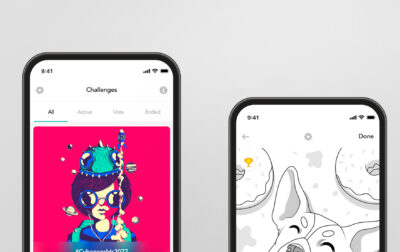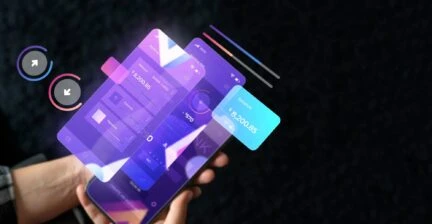APPS BUILT WITH FLUTTER: FEATURES, BENEFITS, AND REAL-WORLD EXAMPLES
Intro
According to the data provided by Statista, Flutter is one of the most popular cross-platform mobile frameworks. Flutter has transformed the way businesses approach app development, enabling cost-effective, high-performance solutions with a single codebase.
For CTOs, VPs of Engineering, and other decision-makers, the question isn’t just why Flutter is popular, but how it can drive business growth. In this guide, we’ll explore real-world examples of Flutter-powered apps, highlight the framework’s key advantages, and discuss the industries where it delivers the most impact. Whether you’re planning a new app or optimizing an existing product, understanding Flutter’s potential could be a game-changer.
Why is Flutter so popular? What features make it stand out? What types of apps are best suited for this framework? Read on to find out.
TECH ADVANTAGES OF FLUTTER APP DEVELOPMENT
Flutter is a powerful framework for cross-platform development, enabling businesses to build high-performance applications with a single codebase. Whether you’re targeting mobile (iOS/Android), desktop (macOS/Windows/Linux), web, or even embedded systems, Flutter provides a streamlined, cost-efficient solution. Here’s how its technical aspects can enhance the business value of your app:
1.
HIGH-QUALITY UI
Flutter has built-in support for both Material Design (Android) and Cupertino (iOS) widgets. Underpinned by a custom rendering engine, this allows building visually appealing and engaging apps that feel native on all supported platforms.
The framework also leverages a declarative programming model that empowers engineers to describe what the UI should look like, without the need to explain ‘how’ it should be achieved. In other words, you can just update the current state, and Flutter will render the UI accordingly, taking off the burden of the very implementation.
Flutter’s widget-based architecture allows composing complex UIs with smaller, reusable parts, without duplicating code. Besides, developers can customize and extend particular widgets, creating and then reusing specific design patterns and functionality.
2.
NATIVE PERFORMANCE
Flutter delivers near-native speed and responsiveness, making it a compelling choice for high-performance applications:
- Compiled to native ARM code for superior execution speed.
- Smooth animations rivaling almost fully native applications.
- Direct access to system resources & APIs, avoiding the performance limitations of other cross-platform tools.
- Hot reload enables real-time code updates without restarting the app, significantly accelerating development cycles.
Flutter’s hot reload feature allows seeing code changes in real-time, without the need to recompile the entire app and losing the current application state. This also means better development efficiency and high app performance during iterations.
Another perk you get with Flutter is its Skia graphics engine that offers high-performance rendering of heavy graphics and animation directly to the screen, bypassing the need to communicate with the native platform.For a deeper dive into Flutter animations, check our recent article.
3.
GREAT COMMUNITY SUPPORT
As we’ve mentioned earlier, the Flutter community is flourishing. As part of this vibrant community, you can access extensive resources, tutorials, and sample projects, notably facilitating and accelerating the development process.
Its powerful ecosystem also gives a great number of packages and plugins for every possible functionality, including state management, networking, database and storage, authentication, image handling, navigation and routing, localization and internalization, notifications, and animation.

KEY BENEFITS OF FLUTTER
By making the most of Flutter’s capabilities and features, you can guarantee the following value for your business.
FASTER TIME TO MARKET
Flutter offers a robust testing framework that significantly accelerates test cycles as compared to native app development frameworks. A single codebase also contributes to faster time to market, as cross-functional teams start to collaborate and communicate better.
BROADER AUDIENCE REACH
Being an official project by Google, Flutter benefits from its global presence and resources. Close partnerships with Microsoft, Intel, and Samsung also contribute better reach and more opportunities in deploying Flutter applications worldwide. Another perk is that Flutter provides extensive accessibility features — such as support for high contrast themes, screen readers, and font size adjustments — extending its use among users with disabilities.
OUTSTANDING USER EXPERIENCE
Flutter’s widgets will help you ensure a consistent look and feel across multiple platforms, enhancing brand recognition and in turn user satisfaction. Better retention and engagement can also be reached through native app performance and top-notch quality (thanks to the framework’s powerful capabilities in early bug detection).
Cost-Effective Development
The Flutter framework allows you to minimize the amount of device-specific code when targeting multiple platforms. And this means less complexity and slashed maintenance costs over time. Besides, Flutter’s built-in testing features enable streamlined unit and integration testing, eliminating the need to turn to costly external tools or QA resources.

CROSS-INDUSTRY APPS DEVELOPED WITH FLUTTER
No matter the niche you’re in, Flutter will make things work. Here are the examples of how the framework’s capabilities revamp apps across industries and business domains.
1.
HEALTH AND FITNESS APPS
For the health and fitness niche, Flutter offers powerful plugins and widgets that you can transform into the following functionality:
- Fitness tracking. With plugins — such as ‘flutter_wearable’, ‘wear_os, flutter_bluetooth_serial’, and ‘android.bluetooth’ — developers can implement seamless and secure integrations with smartwatches, fitness trackers, glucometers, and blood pressure monitors. This allows tracking and analyzing key health metrics, including daily activities, calories burned, heart rate, and glucose levels.
- Location-based features. Flutter’s geolocation plugins are key to monitoring a user’s locations during workouts (for example, jogging, cycling) and enabling functionality around routes mapping, distance covered, as well as location-based marketing.
- Data visualization. Underpinned by the ‘fl_chart or syncfusion_flutter_charts’ plugin, you can empower users with advanced, visually appealing graphs, charts, and reports about their health state and workout progress.
- Notifications about water intake, workouts, or medication alerts are made easier with Flutter’s plugins such as ‘flutter_local_notifications’. This way, you can encourage users to stay committed to their health goals.
Philips HealthSuite is one of the Flutter mobile app examples. The brand harnesses the power of this framework for better integration with all the Philips health devices (including wearables and connected scales). As a result, Flutter facilitates the creation of visual aids such as graphs and charts, so users get an advanced view into their health state.
2.
MEDIA AND ENTERTAINMENT
Speaking about M&E Flutter app examples, let’s delve into what functionality the framework enables around music, podcast, and other multimedia.
- Media playback. Flutter provides ‘video_player’ and ‘audioplayers’ plugins to facilitate the integration of audio and video playback functionality into your app, including real-time streaming, pausing and skipping, and multiple formats handling.
- Animations and image processing. ‘AnimationController’ and extensive animation libraries (for instance, ‘flutter_animated’) will empower you to build visually appealing media. Besides, ‘photo_view’ and ‘image_picker’ tools will help you enhance UX, as users will have various options of interacting with your content, i.e. selecting, displaying, cropping, zooming, sharing, etc.
- Monetization. Flutter will spare you the headache of implementing revenue streams in your app. Its powerful ‘in_app_purchase’ plugin will activate multiple subscription models, content purchasing functionality, and premium features.
- Third-party integrations. ‘http’ and ‘dio’ plugins will facilitate API connections, allowing you to seamlessly aggregate media content from different sources, including databases, media platforms, streaming services, and content delivery networks. Thus, users will have more extensive choices of dynamic content.
Among the brightest Flutter app development examples in this niche is BBC iPlayer. Although this app was primarily built with native code, Flutter capabilities were leveraged to enhance specific functionalities, for example, to create a live TV guide with a responsive UI and enable personalized program suggestions (based on user preferences and behaviors).
3.
TRAVELING APPS
If your goal is to develop a travel and navigation app, here’s how Flutter can serve:
- Geolocation plugins help integrate your app with Google Maps or OpenStreetMap to ensure correct navigation options, location pinning, nearby attractions finding, and other location-based services.
- Notifications. Firebase Cloud Messaging and Flutter Local Notifications will be useful for reminding users of check-in alerts, booking confirmations, travel itineraries, or special offers.
- Payments are made easy in your app thanks to Flutter plugins for Stripe, Razorpay, and Paystack. Travelers can handle secure payments when booking flights, hotels, or tours directly through your app — in a fast and secure manner.
- Data displaying. Flutter’s Dio (a powerful HTTP client for Dart) allows seamlessly performing API calls so that users could get real-time access to travel-related information like flight data, hotel availability, transportation, or car renting.
A famous Flutter app example, TripAdvisor leverages the framework’s pre-designed widgets to create unique pages for travelling attractions, featuring smooth animations and other interactive content.
4.
FINANCE AND BANKING APPS
Financial apps require extra security and ease of use as compared to other Flutter apps examples. Here is how the framework can assist.
- Authentication. With Flutter’s libraries ‘firebase_auth’ and ‘openid’ you’ll have a good night’s sleep, because functions such as user authentication, sign-up, login, and profile management will be simplified and highly secured.
- Forms and input fields are easily created and customized with powerful input widgets. As a result, banking apps users relish easy, straightforward forms such as account registration, transaction details, loan applications, and more.
- Transaction processing. Flutter also eases the way users will handle transactions directly in your app. Plugins like ‘stripe_payment’, ‘flutter_paystack’, and ‘razorpay_flutter’ will ensure ease of use and rock-solid security.
- Charts and graphs. Personal finances and other banking information is presented in well-structured, visually-appealing stats, trends, and comparisons thanks to Flutter’s ‘fl_chartand charts_flutter’ libraries.
FynPay, a digital payment platform, uses Flutter payment processing plugins to enable secure credit/debit card transactions. And its geolocator plugins help users find nearby ATMs or merchants.
More details on how Flutter prioritizes security in development, can be found in this blog post.
LOOKING FOR AN APP DEVELOPMENT TEAM?
DESIGN AND CREATIVITY APPS
There are many Flutter app examples among design and creativity solutions. Flutter capabilities are exactly used for enabling the following functionality:
- Drawing. Flutter’s GPU-accelerated rendering is leveraged by Adobe Illustrator to provide smooth performance, even when the mobile app deals with creating complex designs.
- Smooth UI. Mobile apps such as Canva and InShot Video Editor employ Flutter’s widgets for creating intuitive UIs and professional-looking designs, which allows users to enhance their photo and video content with greater precision and speed.
- Image processing. Flutter helps ensure a high-performance image editing experience in mobile apps like Pixlr and GIMP by enabling features such as touch and gesture support, color correction, exposure adjustments, image pinching, and more.
- Third-party integrations. Design and creativity apps make the most of Flutter’s packages to expand functionality. For example, thanks to integrations with cloud storages, users can save images and backups of their edits directly to the cloud. And pairing up with social networks or mobile chat apps facilitates ready images sharing.
CHALLENGES OF FLUTTER APP DEVELOPMENT AND HOW TO DEAL WITH THEM
Every technology comes with its own challenge, and Flutter is no exception. To build a high-quality solution, you should understand the ins and outs of the framework and its limitations. Here are the common ones you might face during the deployment.
1. NATIVE INTEGRATIONS
Despite the fact that Flutter supports native features, the integration and maintenance of native code might be challenging. Some complexities can be eliminated through a better understanding of the platform’s channels for communication between Flutter and native code. For features that Flutter doesn’t support natively, consider a hybrid approach to development.
2. LEGACY COMPATIBILITY
Integrating the Flutter framework with legacy software can be difficult due to incompatible tech stacks, outdated data formats, and lack of accessible APIs. In this case, you might need to allocate more resources on creating middleware (for data transformation), building new features as microservices, and forming modern API layers.
3. DEPENDENCY MANAGEMENT
Flutter has established itself as a powerful tool for cross-platform development. However, building a high-quality Flutter application requires an in-depth understanding of its capabilities and limitations, especially regarding native integration and platform-specific features. It’s crucial to plan resources, budget, and timelines in advance.
Flutter indeed has an extensive ecosystem of packages, but not all of them are actively maintained. Some packages might not be compatible with the latest Flutter/Dart versions and might not have sufficient documentation and examples. Besides, large package sizes might bloat the size of your app, and new package versions could lead to app malfunction.
To avoid possible issues, stay up-to-date with Flutter new versions and features, invest time in learning all the framework’s peculiarities, and be ready to continuously optimize your code. Depending on the complexities and your business goals, you might need to explore alternative solutions and frameworks.
FLUTTER APP DEVELOPMENT: TOUCHLANE’S SUCCESS STORY
SmartVolt startup addressed Touchlane to build an MVP of a cross-platform mobile app for energy consumption tracking. Our team participated in enhancing almost every development aspect — from IoT controllers app design to system architecture creation. The Flutter framework was particularly used to introduce the following app functionality:
- Data caching. By using local database packages provided by Flutter, Touchlane enabled easy data storage of essential data such as user sessions, previous charging history, and configurations. Users are able to access this data offline when needed (without constantly fetching it from the server), facilitating the overall navigation through the app.
- Remote configuration. Touchlane capitalized on Flutter capabilities to allow dynamically adjusting the app settings and features based on user feedback or real-time market conditions. This includes testing different UI layouts, changing promotional messages, or toggling features based on user segments — sparing the need for SmartVolt to push app updates through app stores.
- Secure authentication. The implementation of Firebase Authentication enabled a secure, streamlined sign-in experience for SmartVolt users, using multiple authentication methods such as email/password, social logins, and more.
The customer was happy with the delivered results and additional functionalities enabled by Flutter and the Firebase ecosystem, which resulted in hiring Touchlane for the development of a full app version.
Conclusion
As multiple Flutter app development examples show, the framework is continuing conquering the mobile cross-platform development market, and it’s high time you catch the trend. The implementation of this tool in your app development will allow you to extend your presence to new markets, scale your product, and ensure utmost user experiences — all while slashing development and maintenance costs down.
Experts in cross-platform app development, Touchlane is ready to assist you on the way to success. Contact us communicating your Flutter app idea, and we’ll get back to you to discuss the implementation details.
RELATED SERVICES
CUSTOM MOBILE APP DEVELOPMENT
If you have an idea for a product along with put-together business requirements, and you want your time-to-market to be as short as possible without cutting any corners on quality, Touchlane can become your all-in-one technology partner, putting together a cross-functional team and carrying a project all the way to its successful launch into the digital reality.
If you have an idea for a product along with put-together business requirements, and you want your time-to-market to be as short as possible without cutting any corners on quality, Touchlane can become your all-in-one technology partner, putting together a cross-functional team and carrying a project all the way to its successful launch into the digital reality.
We Cover
- Design
- Development
- Testing
- Maintenance











